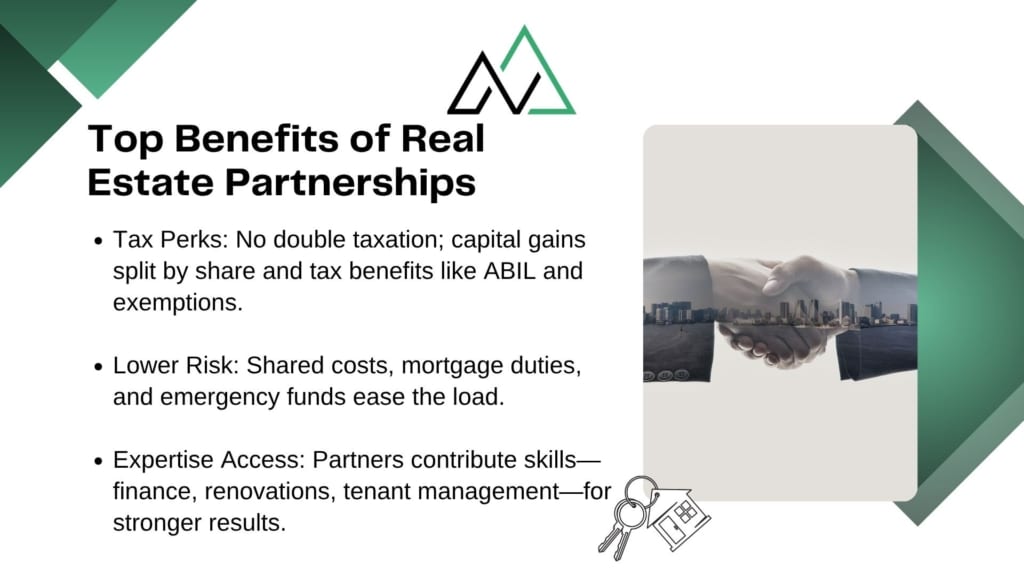In Canada, a real estate partnership lets two or more people own property together. They do this for shared financial goals. CRA rules say they can split profits, losses, and tasks.
Partners can buy investment properties or develop land. They use their combined money and skills. This way, they can tackle bigger projects together.
These deals can be either formal or informal. While some provinces accept verbal agreements, written contracts are safer. They make sure everyone knows their role and how to leave the partnership.
Many investors in Canada use partnerships to get into markets that need big investments. This guide will show you how partnerships work under Canadian law. You’ll learn about taxes, different partnership types, and how to make good agreements.
New Homes Alberta offers trusted advice. They help you understand joint ventures. Whether you’re buying your first rental property or growing your portfolio, they’ve got you covered.
Key Takeaways
- Legal collaborations where multiple parties jointly own property assets
- Profits and losses divided according to partnership terms
- Both verbal and written agreements recognized (varies by province)
- Enables access to larger investments through pooled resources
- Requires clear documentation of roles and financial commitments
- Must comply with CRA reporting requirements
- Offers strategic advantages for new and experienced investors
Understanding Real Estate Partnerships in Canada

Exploring property investments in Canada often leads to real estate partnerships. These partnerships let people combine resources, share risks, and benefits. But, how do they fit into Canadian laws? Let’s dive into the basics.
Legal Foundations Under Canadian Law
The Canada Revenue Agency (CRA) says a real estate partnership is when two or more people work together on a property. Unlike simple co-ownership, partnerships need four main things:
- Profit-sharing agreements: Everyone must share income/losses fairly
- Joint liability: Partners are personally on the hook for debts (except in limited partnerships)
- Resource contributions: All members bring in capital, skills, or labor
- Formal documentation: It’s best to have a written agreement, but verbal ones are okay too
Key Characteristics of Partnership Structures
Good real estate partners set up clear rules for working together. Partnerships are different from being alone because they share decisions. They also differ from companies because taxes flow directly to the partners, not the business.
How Partnerships Differ From Other Ownership Models
Canadian investors have many ways to invest in properties. Here’s how partnerships stack up against others:
- Vs. REITs: Partnerships give you control, while REITs are more hands-off
- Vs. Fractional Ownership: Partners share risks, but fractional owners only risk their part
- Vs. LLCs: Partners’ personal stuff might be at risk, unlike LLCs
- Vs. Solo Ventures: Sharing costs means less financial burden for each person
This setup is great for those who want to manage properties closely with others. While partnerships need careful planning, they let you access bigger properties and more varied portfolios than going it alone.
Common Structures for Canadian Real Estate Partnerships

Choosing the right partnership model is key to meeting investor goals and legal needs. In Canada, three main frameworks stand out. Each has its own benefits based on your project and risk level.
General Partnership Framework
General partnerships (GPs) share equal management and liability among partners. Alberta’s Partnership Act makes all members responsible for debts. This is good for:
- Small residential projects with trusted partners
- Those wanting equal say in decisions
- Short-term investments needing fast decisions
Limited Partnership Arrangements
Ontario’s Limited Partnerships Act lets silent investors join. Here’s how it works:
- General partners manage the project
- Limited partners invest without control
- Profits are taxed individually
Liability Considerations in Alberta
Alberta limits limited partners’ liability to their investment. Recent changes require written agreements for:
- Capital contribution limits
- Profit sharing formulas
- Dispute resolution methods
Joint Venture Models for Property Development
Real estate joint ventures are common for commercial projects. A Calgary shopping center might use this model with:
- 12-24 month construction phases
- Clear exit plans like selling the property
- Specialized roles like land acquisition or construction management
Developers often mix JVs with limited partnerships. This balances sharing expertise and managing risks.
Benefits of Forming a Real Estate Partnership

Real estate partnerships offer big advantages for investors and homebuyers in Canada. By working together, partners can tackle tough property markets better. They also get to improve their financial results. Let’s look at three main benefits that make partnerships attractive.
Tax Advantages Specific to Canada
In Canada, partnerships get special tax perks. They don’t face double taxation like corporations do. This lets partners manage their taxes more freely.
Capital Gains Treatment in Partnership Structures
When selling property, partners split capital gains based on their share. Important points to remember include:
- Using individual capital gains exemptions (up to $913,630 in 2023)
- Sharing allowable business investment losses (ABIL)
- Meeting T5013 filing thresholds (required for partnerships with $500+ in revenue)
Risk Mitigation Through Shared Investment
Sharing costs and risks lowers each partner’s burden. For instance:
- Splitting down payment costs among partners
- Sharing mortgage responsibilities
- Pooling funds for emergencies
Access to Combined Expertise and Resources
Partners bring different skills to the table. Roles might be divided like this:
- One partner handles financing and mortgage approvals
- Another manages contractors and renovations
- A third focuses on tenant screening and leases
This teamwork helps partnerships overcome big challenges. From getting zoning approvals to upgrading properties, they’re better equipped.
Creating a Real Estate Partnership Agreement
A good partnership agreement is key to a successful real estate partnership in Canada. It outlines roles, safeguards investments, and clarifies rights. Let’s look at what makes these agreements effective under Canadian law.
Essential Contract Components
Canadian real estate partnerships need six main elements in their agreements. Ontario’s Partnerships Act serves as a guide for other provinces:
- Listing all partners and their shares
- Rules for capital contributions and deadlines
- Who manages the partnership and voting power
- How profits and losses are shared
- Steps for adding or removing partners
- When and how the partnership ends
Profit Distribution Clauses
Most partnerships in Canada follow a waterfall model. This means:
- First, return the initial investment
- Then, give preferred returns (6-8% a year)
- Lastly, split the rest 50/50 between investors and operators
Dispute Resolution Mechanisms
Alberta suggests a three-step process for handling disputes:
- Start with mandatory mediation within 30 days
- If that fails, move to binding arbitration
- Go to court only as a last resort
Provincial Registration Requirements
In Alberta, partners must follow three steps under the Business Corporations Act:
- First, reserve a business name through the Corporate Registry
- Then, file a partnership declaration with important details
- Lastly, get a provincial business number
Ontario also has extra rules for partnerships focused on development. They need environmental impact assessments for certain properties.
Managing Partnership Responsibilities
Successful real estate partnerships need clear systems for finances and decision-making. Whether you’re investing in a Calgary condo or Toronto townhomes, knowing these roles keeps your venture smooth and free of conflicts.
Financial Reporting Obligations
Canadian partnerships must file Form T5013 by March 31st. This form shows each partner’s share of income/losses. It’s sent to both the CRA and partners. Important points include:
- Reporting all partnership income within 90 days of fiscal year-end
- Maintaining records for 6 years (CRA requirement)
- Disclosing Ontario Securities Commission (OSC) compliance for investment-focused groups
Missing deadlines can lead to penalties up to $2,500 plus 1% monthly interest on unpaid taxes. Use accounting software like QuickBooks Canada to make profit allocations easier.
Decision-Making Protocols
Good governance stops disputes over property management or exit strategies. Most partnerships follow:
- Unanimous consent: All partners must agree (common for major asset sales)
- Majority voting: Decisions pass with 50%+1 votes (used for routine operations)
Voting Rights in Alberta Partnerships
Alberta’s Partnership Act lets you set your own voting rules. A 2021 Edmonton court case confirmed a partnership agreement where:
- General partners had 60% voting power
- Silent investors voted only on capital calls over $100k
- Tie-breakers went to the managing partner
Always write down your voting rules in your partnership agreement. Ontario courts have recently supported claims against partners who ignored agreed protocols.
Working with Real Estate Professionals
Building successful property partnerships in Canada often requires working with experienced professionals. They know the local markets and legal frameworks well. The right team can make processes smoother and protect your interests.
Role of Licensed Brokers in Alberta
Certified real estate brokers in Alberta have three main roles in partnerships:
- They help keep communication clear between partners.
- They make sure all rules are followed.
- They give market analysis for better decisions.
These experts help write agreements that are good for partnerships. They also explain how different ways of owning property affect taxes. Their knowledge is very useful for projects with many owners or developments.
New Homes Alberta Partnership Services
This organization in Alberta offers special help for real estate partnerships. They provide:
- Help in solving partnership problems.
- Info on different ways to own property together.
- Guidance on Alberta’s new home warranty program.
If you have questions about property developments for partnerships, reach out to their support team.
Contact Information: (403) 305-9167
Conclusion
Real estate partnerships in Canada are great for investors and homeowners. They work together, sharing money and skills. This way, they can use their resources better and save on taxes.
It’s important to have clear agreements. These agreements should cover how profits are shared, how decisions are made, and how to exit the partnership. Each province has its own rules, like Alberta’s for joint ventures. Working with experts helps follow these rules and work smoothly.
Investors benefit from sharing risks and working on bigger projects. They can choose from different partnership types, like limited partnerships. This lets them pick how involved they want to be and how much money they risk.
Knowing your legal and financial duties is key to a good partnership. Keeping agreements up to date and checking the market helps partners stay on the same page. With good planning and expert advice, real estate partnerships in Canada can be very successful.

